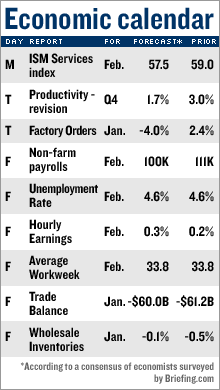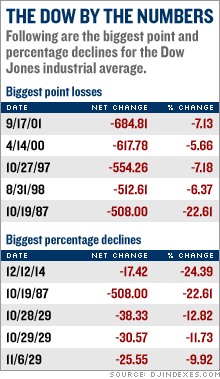Stocks: Expect more anxietyInvestors crawl back to work Monday after toughing out the worst week on Wall Street since 2003. And the choppiness may continue.NEW YORK (CNNMoney.com) -- After surviving the worst week on Wall Street in nearly four years, investors return to face what could very well be another endurance test. Get ready. With no meaningful earnings reports due and most of the relevant economic reports not expected until Friday, the week ahead is likely to bring more choppiness and few anchors.   Stocks slumped across the board last week, as a massive selloff in Chinese markets on Tuesday caused a domino effect across a variety of world markets, including the United States. Tuesday's selloff sent the Dow down 416 points in its worst one-day decline since the day the markets reopened after the 9/11 attacks. For the week, the Dow Jones industrial average (Charts) lost 4.2 percent, its worst one-week decline on a percentage basis since March 2003. And the rest of the stock market had just as rough a time. (Full story). "The market basically had a mild heart attack," said James Awad, president at Awad Asset Management. China got the ball rolling, but it wasn't just the international markets that spooked U.S. investors last week. It was also a surprisingly weak read on durable goods orders and a run-up in a key inflation indicator. Comments from former Federal Reserve Chairman Alan Greenspan that the economy could be heading for a recession by the end of the year didn't help. There was also a plunge in the dollar as global traders rushed to close out carry trades, or bets on riskier currencies financed by borrowing in the currencies of countries with low interest rates, like Japan. Another factor: renewed worries about the fallout for subprime mortgages - home loans given to borrowers with bad credit histories. Then add in the fact that stocks had basically been climbing for eight months straight, since bottoming last summer. Just prior to the selloff, the Dow Jones industrial average and the Russell 2000 had both hit all-time highs, while the Nasdaq composite (Charts) and the S&P 500 (Charts) had both hit more than 6-year highs. "We were overdue for a pullback," said Fred Dickson, chief market strategist at D.A. Davidson & Co. "Our feeling is that this will be a fairly short, somewhat volatile, violent correction that that will last a few weeks or a month," he said. "But is it the start of a bear market? No." Dickson said that U.S. markets will eventually stabilize and recover, but that global markets probably need to recover first. The so-called fundamentals of the economy didn't change last week, with many economists still looking for slow, but not too slow, growth and waning inflation. The Fed is still expected to remain on the sidelines for now - Fed chair Ben Bernanke hinted as much when he spoke last week. The huge amount of deals activity, in both public companies and private equity, is not expected to slow. What changed last week fairly abruptly, and is likely to continue to weigh on stocks for the time being, is the great appetite for risk, Awad said. He said that the zest for risk - including emerging markets, currencies, housing - contributed to the huge run-up in equities over the last few years, but it also left stocks vulnerable. That vulnerability was triggered by the harsh selloff in Chinese stocks. "What you're having is a reality check," Awad said. "The market is being fueled by liquidity and some of the liquidity is drying up. Fear is in the marketplace. You're probably going to have a noticeable correction." That so-called correction is likely to stretch into next week and possibly beyond, the analysts said. Next week brings reports on the services sector on Monday, factory orders on Tuesday, the Fed's beige book of economic activity on Wednesday and the monthly jobs report on Friday. (See chart for details). In general, "you want to see evidence of both weaker and stronger growth, so there isn't a big sign of accelerating on the downside," said Steven Goldman, market strategist at Weeden & Co. Investors will also be attuned to comments from a number of Federal Reserve Board speakers. On Monday, St. Louis Fed President William Poole and Fed Governor Kevin M. Warsh are both expected to give talks, while on Wednesday, Chicago Fed President Michael Moskow is expected to speak. |
|
